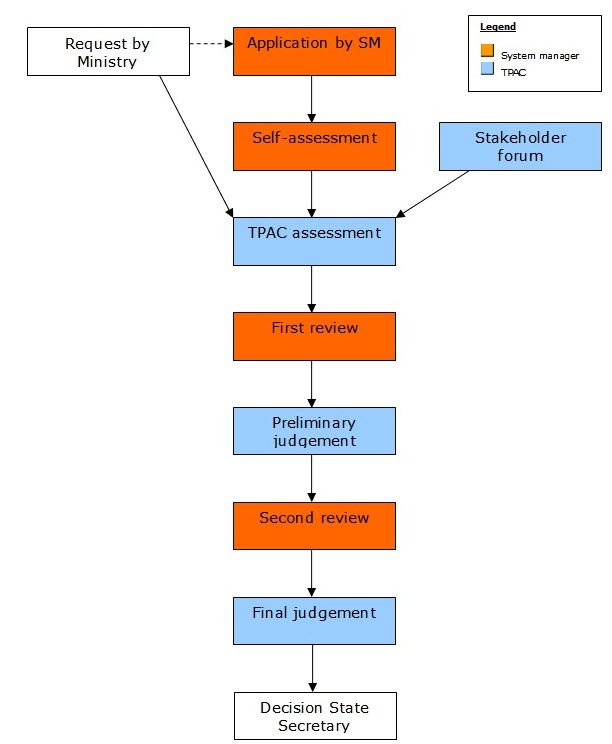This figure shows the assessment procedure of TPAC. Beneath the figure an explanation is given of the different steps. The complete assessment procedure can be read in the User Manual (see procedural documents).

There are two possibilities for starting the assessment procedure:
In addition to the “paper” assessment of a certification system, TPAC gathers information on the functioning of the system “in practice”. This includes amongst others an online stakeholder forum.
At the online stakeholder forum, NGOs, timber companies and all other stakeholders of sustainable forestry are invited to comment on the certification system at hand (see how to use the forum).
The self-assessment implies the completing of the assessment matrices (see documents). These matrices constitute a reproduction of the Procurement Criteria, which allow the system manager to match the system’s own criteria with the Dutch Procurement Criteria.
Following the domains of the Procurement Criteria, there are three matrices:
The self-assessment has to be based on the official system documents, i.e. standards, technical documents, procedure documents, by-laws, or where relevant other legally binding documents.
The assessment performed by TPAC consists, analogous to the self-assessment, of the “matching” of the Dutch Procurement criteria with the criteria of the certification system. In addition, the Committee takes into consideration the input of the stakeholder forum and the self-assessment, if applicable. In this assessment, the legal and social context within which the certification system operates, is explicitly taken into account.
On some issues, the Committee may require additional information to be able to make an accurate assessment; these information requests will be sent along with the TPAC assessment to the system manager.
An important element of the TPAC assessment procedure is the review by the system manager. This review takes place at least two times during the procedure: the first review after TPACs assessment and the second review after TPACs preliminary judgement.
During the first review, the system manager is expected to address all information requests the Committee furmulated. But the system manager is also free to comment on all other elements of the assessment if necessary. Again, where possible, the review should be based on official system documents such as standards and by-laws.
Following the first review, TPAC will make a preliminary judgement of the certification system based on all information obtained during the assessment procedure.
The second review can be considered a “final check” by the system manager before the Committee makes its final judgement: only if new information is provided, the comments are taken into account.
After the second review, the Committee will make a final judgement of the certification system. This judgement may be “system conforming” or “system not-conforming”. This judgement is communicated to the system manager before making the results public. If the final judgement is “system conforming”, this implies that timber certified by the certification system in question meets the Procurement Criteria and therefore can be procured by Dutch government organisations as sustainable timber.
The final decision whether a certification system is accepted for the Dutch Procurement Policy is made by the State Secretary of Environment